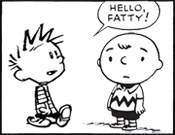|
Adding this since you were asking for advice on hands earlier and no one posted it (for shame!): https://line-of-action.com/practice-tools/hands-feet-practice/ That aside it's hard to give you much advice on your character designs with so little information. Who are these people? What's their function in the story? What kind emotion do you want them to elicit from your viewers? You see, the key to good character design IMO has less to do with technical proficiency (though that's still important) and more to do with clear communication and controlling the assumptions your viewers make when they look at your designs. So for example if you want to make a character appear suspicious you do things like make them lanky and give them small, squinty eyes. Of course, you can get much more subtle/abstract about it than that (line quality, posture, props, clothing, silhouette, color schemes, textures, etc), and you're free to subvert these assumptions later, but the important thing is that you know what you want to say and communicate it effectively. Master this, and you can accomplish quite a lot even with minimal technical skills. For an example of this in action I'd point to the goon-run webcomic It Hurts (occasionally NSFW): http://gobolatula.com/ithurts/  Now, if we're being brutally honest Gob's not the greatest artist on a purely technical level. The man breaks all the art rules all the time. Yet despite this his comics are still pretty fun to read. Why? Because Gob is secretly a pretty good writer and his art very effectively communicates what he needs it to. His character designs are generic, but they're competent *enough* to not get in the way and they tell you what you need to know to follow the story. Pasq is a child but not terribly extraordinary. He has big round eyes and a big head which communicate innocence and wears khakis and a polo shirt which shows that he's a touch uptight and socially awkward. He's pale, showing that he doesn't go outside much, and his expressions generally reveal him to not be the sharpest tool in the shed. In short, every element of the design, while crude, works towards what Gob is trying to do. My point is that I can't really give you terribly great advice since I don't know what exactly it is you want to do with these characters. The best advice I can give you at this point is to design with these things in mind while continuing to expand your technical skillset. Your nerd is actually not terrible on this front (He has personality and I get what you were going for) but your slacker was less successful. Who's he supposed to be exactly? Adding a slouch was a good decision (though your pose didn't factor in the character's pelvis. Always draw the figure under the clothes!) but I still don't know what you want me to feel about him. Is he supposed to be likeable or do you want the audience to think he's a goober? Is he smart or dumb? Young or old? His big head and backwards hat indicate youth but his thin hair and long features indicate someone older. A large part of the problem is his eyes. He kind of resembles Dr Doofensmirch but lacks the Dr's eyebrows, which makes him far less expressive. The eyes also don't quite match which is a tad offputting.:  As a learning exercise I'd also consider trying to redesign your characters as if you were planning to render them in 3D. Draw them from multiple angles and ask yourself how you'd turn them into action figures if you had to. Doing this will help you understand them as forms that take up space in their world rather than abstract symbols. Believe it or not most artists, even those who who do heavily abstracted work, are thinking largely in three dimensions. That's why Disney can make figurines of Phineas despite his bizarrely shaped head:   Some figure drawing lessons could also help. While, again, they're not essential to making enjoyable art they do provide a set of tools that will be very helpful in getting your ideas across. I'd recommend starting with proportions since they both let you fix your mistakes and help you exaggerate/caricature. And as always, finish a ton of work. That will improve your skills faster than anything else. Good luck! Hope that was useful. readingatwork fucked around with this message at 02:48 on Jul 9, 2017 |
|
|
|

|
| # ¿ May 21, 2024 05:30 |





